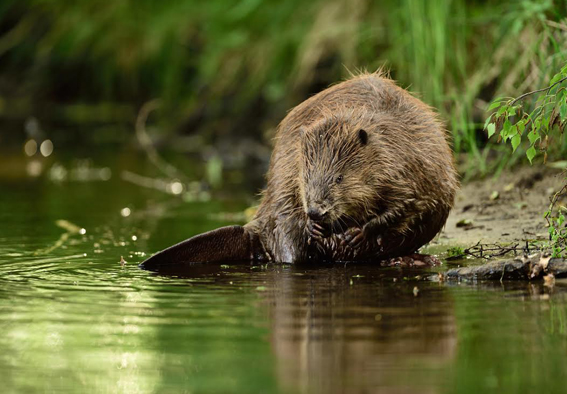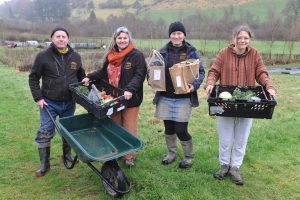PLANS to reintroduce beavers to the Cors Dyfi Nature Reserve have been criticised by the local branch of the FUW.
The Montgomeryshire branch of the union described the plans as ‘a short-sighted move’.
FUW Montgomeryshire County Executive Officer Emyr Wyn Davies said: “We believe there is insufficient evidence to conclude that this animal does not pose a threat to livestock and the people living here, including bringing disease into the area. That’s just one of many concerns and we are extremely worried about this short sighted move.”
Other concerns raised by the FUW about the reintroduction of the beaver include the animals damming watercourses, which could severely impact the adjacent agriculture land; the risk of the animals escaping their enclosure and the low lying levels of the Dyfi, which are already prone to flooding through natural means – the introduction of an animal which dams watercourses by instinct is likely to exacerbate the flooding propensity for this area.
Emyr Wyn Davies continued: “We must also consider what happens if a landholding in close proximity to the proposed enclosure enters a Welsh Government agri-environment scheme to increase biodiversity habitats by tree planting and on a Welsh Government inspection is found to be in breach of contract because of vegetation damage by beaver activity – which organisation compensates the at loss landowner?
“Furthermore, will NRW have a legal obligation to monitor and clear debris entering water courses as a direct result of beavers felling timber?” Mr Wyn Davies questioned.
He added that whilst the farming community is supportive of increasing biodiversity and habitats, this must not come at the expense of people living in an area.
“Let’s also not forget the ambulances getting through to Bronglais Hospital on a stretch of road next to the proposed release site that’s only just stopped flooding whenever it rains – the alternative is a 60 mile detour!”
Reintroducing a species which has been absent for over 400 years is a challenging project from an ecological and social perspective.
Over such a timescale, the ecosystem and its biodiversity have changed considerably due to a host of natural and anthropogenic drivers. Moreover, people have forgotten that beavers were a natural ecosystem component and so species that have been absent for hundreds of years may now be considered as invaders or intruders despite being originally native.
There have been more than 200 formal beaver reintroduction projects (plus numerous unofficial releases) in more than 26 European countries.
Beavers are often referred to as ‘ecosystem engineers’. They make changes to their habitats, such as digging canal systems, damming water courses, and coppicing tree and shrub species, which create diverse wetlands. In turn these wetlands can bring enormous benefits to other species, such as otters, water shrews, water voles, birds, invertebrates (especially dragonflies) and breeding fish.
However, through their activities, there’s the potential for beavers to come into conflict with land management, flood defence and fisheries interests
Additional problems arise when so-called ‘re-introducers’ release species into the wild unchecked and outside the stringent statutory procedures regarding wild animals return to UK habitats.
The reintroduction of beavers into the Scottish countryside almost came unglued after the unauthorised and unmonitored release of beavers to waterways around Tayside.
With regard to the illegal releases on the Tay, both the reintroduction process and the government’s response in Tayside (the Scottish Government declined to act) had been responsible for fuelling the conflict there.
Previous deliberate and ultimately disastrous introductions of non-native animal species into the Welsh countryside, for example mink, have also undermined the case for reintroducing once-native species.
In beavers’ case, the issue isn’t just about the reintroduction of a species – it’s about the reintroduction of an entire ecosystem that disappeared over 400 years ago..
Those who support beavers’ reintroduction say it will benefit both farmers and wildlife because beaver dams help reduce downstream flooding by holding back water and releasing the water slowly after heavy rain while reducing silt build-up.
However, research into Scottish releases revealed that among those opposed or sceptical about beavers’ reintroduction, identified that while projects listed ‘desired outcomes’, none of them considered what to do if those ‘desired outcomes’ were not achieved. The need to control beavers, their spread and absence of long-term funding for their management was also a concern.
Reintroductions involve humans. Individuals or groups carry out these projects which, in turn, have an effect on landscapes and the way they are being inhabited, used or simply perceived. In light of this, any reintroduction project is challenging. It implies looking at a specific species, its effects on the environment and people’s perceptions and acceptance of it. It also requires engaging in effective discussions which involve all the actual and potential stakeholders, without labelling them, to agree on a broad and long-term plan for the landscape.
The lack of trust between wildlife/conservation groups and farmers is the largest barrier to reintroductions’ success. In the case of the Dyfi Biosphere, the controversial Summit to Sea project drove a wedge between local farmers and projects involving species’ reintroduction which will take many years to resolve.
Bringing back beaver















Add Comment